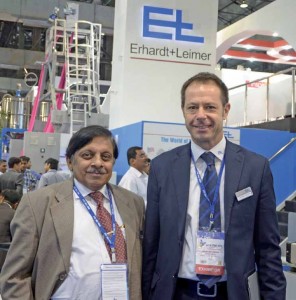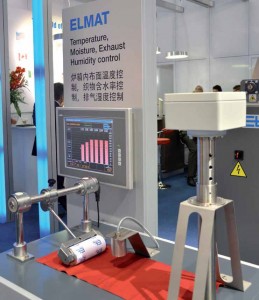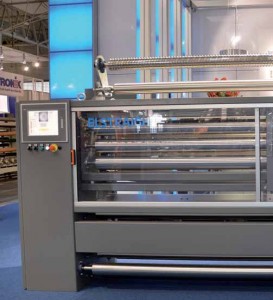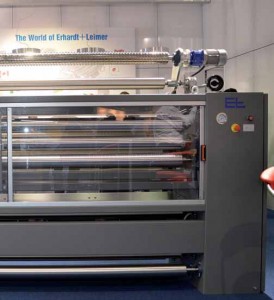 E + L has developed and filed a patent for a new camera with two integrated lenses (wide-angle and telephoto lens). This solution offers an optimal picture resolution for each pick density. This is especially important in case of very high pick densities and complex fabric structures.
E + L has developed and filed a patent for a new camera with two integrated lenses (wide-angle and telephoto lens). This solution offers an optimal picture resolution for each pick density. This is especially important in case of very high pick densities and complex fabric structures.
The camera is mounted in 250 mm distance. This will avoid problems arising from pollution and high fabric temperatures. The process is contact-free; it does not require a moving web and is therefore most suitable for laboratories – not only for very low densities like carpet with 2-3 picks per cm but also for very high densities of technical fabrics with more than 200 picks per cm.
To evaluate low pick densities does not cause any problem for a camera. In order to reach a high accuracy, it is important to evaluate a very wide measuring range (max. 120 mm). In case of very high pick densities, we go the opposite way round and minimize the area to be analyzed in order to resolve the fine structures safely.
 This task is solved either by means of a motorized auto zoom or via a digital zoom procedure. Motor zoom is very expensive due to the sophisticated mechanics. It is prone to vibrations and wearing out. Digital zoom with a standard lens uses only a small part of the CCD chip pixels when the zoom factor is high and is therefore only an inadequate solution.
This task is solved either by means of a motorized auto zoom or via a digital zoom procedure. Motor zoom is very expensive due to the sophisticated mechanics. It is prone to vibrations and wearing out. Digital zoom with a standard lens uses only a small part of the CCD chip pixels when the zoom factor is high and is therefore only an inadequate solution.
In weaving mills, control of settings regarding pick density on running weaving machines is possible. Here, it is sufficient to make one random examination per machine and shift or day.
The picture evaluation does not require a moving sample and is therefore ideally suitable for the use in laboratories. A commercial computer with E+L evaluation software is connected via Ethernet to ELCOUNT.
Using a camera at the exit of a finishing machine offers advantages like low investment costs, 100 per cent control of the goods produced and the facility to adjust the optimal fabric overfeed as per the results of the evaluation.
 Using two ELCOUNT cameras at the entry and the exit of a finishing machine helps correct pick density by automatic guiding of the overfeed, for example in shrinking machines.
Using two ELCOUNT cameras at the entry and the exit of a finishing machine helps correct pick density by automatic guiding of the overfeed, for example in shrinking machines.
ELCOUNT does not only detect the density but also measures the angular position of the weft thread. If you use a camera on each side of the exit, you can detect also the rest distortion of bow and skew distortions. Simply and at a reasonable price you can achieve a great additional benefit by the use of only one further ELCOUNT camera.
Denim does always have a defined rest skew distortion. Using two cameras at the exit, the rest skew distortion can be measured and the correct angular position of the weft thread can also be corrected via communication with the automatic weft straightener EL-STRAIGHT.
Today, it is most essential to meet the preset rest shrinking values. If the specifications are not met, there will be massive losses in price or an order or even a customer is lost. Therefore, the finishing industry tends to excessive shrinking, which is not necessary. The higher the fabric density, the shorter the length of the material to be sold.
ELCUT BTA 80, the ultimate solution for optimum edge trim
As a matter of principle, superlatives like “ultimate” are taboo when describing products. Sometimes, however, they are a must, and this is particularly true for the new cutting system ELCUT BTA 80 of the web guiding specialist Erhardt+Leimer.
The ELCUT BTA 80 system fully meets the requirements of knitted fabric manufacturers: Substantially reduced cutting waste, minimum maintenance, long life, and easy retrofitting of old cutting devices.
 Quite a number of sophisticated details reflect more than 90 years of experience of Erhardt+Leimer in the field of web guiding and cutting systems. Long-life blades that can be used on both sides, an actuator allowing exact positioning of the system via two push buttons, or automatic follow-up control of the cutting devices by web edge via sensors guarantee top performance at minimum effort.
Quite a number of sophisticated details reflect more than 90 years of experience of Erhardt+Leimer in the field of web guiding and cutting systems. Long-life blades that can be used on both sides, an actuator allowing exact positioning of the system via two push buttons, or automatic follow-up control of the cutting devices by web edge via sensors guarantee top performance at minimum effort.
There are three versions of ELCUT BTA 80: The basic version is supplied with an actuator allowing exact manual positioning via two push buttons. The second basic version includes a sensor with a captive range of ±3 mm. When the web width changes, the sensor has to be positioned manually once, then the system automatically follows the web edge. The premium version is supplied with a wide band sensor that has a captive range of ±75 mm. When the web width changes the new position of the web edge is fixed at the push of a button. Due to its wide captive range the web is always in the field view of the sensor.
Whether you opt for the basic or premium version, the ELCUT BTA 80 system convinces through continuous concentration on customer demands, minimum maintenance effort and high value for money. This makes it the ultimate solution for optimum edge trim.
ELFEED KRS 60
The new tenter infeed system ELFEED KRS 60 with new infrared edge sensor FR 5503 is an all-in-one AC/EC compact actuator.
Integrating the motor and controller in one enclosure will offer advantages like reduction of assembly work and cabling by 70 per cent, application of low-priced, unshielded standard cables, short cable paths reducing losses and possible external disturbances, an efficient brushless AC motor, and direct AC-line operation between 100 V-250 Volt 50/60 Hz (no transformer).
The infrared edge sensor FR 5503 is based on the latest generation of CCD chips. The infrared illumination has been optimized, and sensitivity and controller settings can be adjusted on the sensor. Combined mechanical and optical edge scanning is also possible.
The high dynamic of the new actuator and the further optimized sensor FR 5503 allow a safe and even more accurate pinning: Each millimetre which is saved in the depth of pinning will reduce waste. A reduction of 2 mm per side, at a service performance (Europe/Asia) of 25/30 million metres/year and a material price of EUR 2, reduces the cost by EUR 13,000/16,000 per year.
ELMAT
The low moisture control EL Hygromatic optimizes product quality by means of correct residual moisture. Energy costs are reduced by avoiding over-drying of the web. At the same time, the performance of the dryer is maximized.
The energy consumption of a dryer essentially depends on the amount of water vapour in the exhaust air. A greater volume of water vapor means that there is lower volume of air that has to be warmed up from the ambient temperature to the exhaust gas temperature. Optimum energy saving and constant process conditions are ensured using the exhaust air humidity control EL HygroAir.
EL TempMonitoring
The quality of a textile made of thermoplastic synthetic fibers depends greatly on adherence to the correct setting parameters. For this purpose exact web temperature measurement using infrared pyrometers and precise adherence to the required setting time is imperative.
Using the thermosetting control EL TempMonitoring an optimal result can be obtained. A minimum of four and a maximum of eight chambers can be monitored.
If there is no low residual moisture measurement on the outfeed from the dryer, a rough estimation of the residual moisture of the web can be obtained by measuring the web temperature at the outfeed.
All these functions are integrated into a single device in the ELMAT system. Operation and the indication of all measured results are self-explanatory. Special product data can, if required, be saved in the device’s memory in the form of parameter sets.
ELMAT is the optimum solution for the end customer to upgrade the existing drying machines. Of course, the system is also suitable for use by machine manufacturers who do not want to go to the expense of programming their own data display and control.
Digital ELSMART SWS 91
During conception of the SWS web guiding systems the priorities were clearly set on a compact construction, designed for low web tensions and maximum speeds of 50 m/min. All other properties and technical characteristics are identical to the other E+L segmented roller guided systems. Due to the technical design, the SWS 91 is ideally suited for use in digital presses and shrinking units for knitted fabrics.
The additional drive system with integrated frequency converter shown in the picture is an option and usually not needed since the roller starts very easily.
Digital ELSMART SWS 94
In all available configurations the SWS 94 can be used up to a maximum web speed of 200 m/min and a working width of up to 3600 mm. The system itself is mounted on a flange. The web guiding can be rotated. Thus the web running works even slant to the horizontal and vertical.
The system is smaller and lighter and is applicable in printing machines, for integration into machine housings, e.g., calenders used in transfer printing, and for mounting on winding systems.
Digital ELSMART SWS 95
This is a digital web guiding system in “box format”. The side boxes allow a simple assembly of a spreading device with driven spreader rolls and the additional mounting of a rotary tensioner. In this configuration, the customer gets a complete machine feed that can be fixed with a few screws to a vertical or horizontal girder. The entire electronic system is integrated in the side. After the power supply is connected, the system is operational.
An electric actuator and a digital PID controller allow maximum web speed of 220 m/min and working width of 3600 m/min.
The available sensors are the FE 40 broad band sensor, FE 40 broad band sensor for edge scanning different edge positions are easily adjustable over the complete measuring range, FR 50 infrared edge sensor, and the FR 60 infrared broad band sensor ±75 mm.
The possible guiding modes: Center guide rail: FE 40, Web edge guiding FR 50, FE 40, FR 60 and controlled web width control for elastic materials (to web center, edge or rail).
SWS 9501 mohair guiding rails
In contrast to the SWS 95, the SWA 95 is equipped with a pneumatic actuator, a digital three-point controller and a wide band sensor FE 40.
The maximum web speed is 130 m/min and the guidance accuracy is ±5 mm. The dimensions are identical to SWS 95.
SWS 96 and 97 are used in wet and chemical-related applications. SWS 97 in flange design (for integration in textile machines) comes with operating temperature of up to 100°C and chemical inputs of PH 1 – PH 12.
The segmented roller guided system ELSMART SWS 97 is specially designed for web guiding and spreading of one or two parallel coated fabric webs in bleaching steamers. E+L systems for bleaching steamers and similar finishing machines are well known for their reliability and functionality in web guiding. Based on customer requests there is a continuous improvement process to meet the demands of the market. One result is this new variation of the SWS 97. As a world novelty it allows to run two webs of 1400 mm in systems with a working width of more than 3000 mm. The switching from one to two webs and vice versa can be managed with a minimum of work and time effort.
Technical requirements
• Two independent control loops in the segmented roller guide for each web
• An intelligent wide band sensor, which guarantees center web guiding both in single-web operation as well as in two-web operation. (The sensor recognizes the center of each web separately)
• Using the mode CENTER enables the operator to run two webs of different width simultaneously.
• An upstream spreading device with specially wound spreader rolls guarantees wrinkle-free operation of both webs.
Since the early 1990s E+L supplies web guiding system for use in bleaching steamers and washing systems. Operating temperatures up to 100°C and the use of highly corrosive chemicals place highest demands on the materials and the sensors. Production speeds of up to 100 m/min and above are now the rule. Production with two webs means time saving of 40 per cent, energy saving of 45 per cent and almost doubling of production in two-web operation.
ELSMART SWS 96
This system has an operating temperature of 60°C.
Guiding slats: PVC, stainless steel, stainless steel perforated sheet. The wide band sensor FE 4011 (Plexiglas tubes) FE 4013 (glass tubes) must be selected according to the application. Maximum webspeed is 100 m / min.
ELSPREADER LG 06 is a spreading device with two counter-rotating spreader rolls. It comes with side panels painted steel sheet and in stainless steel (1.4301, AISI 304), and drive motor 0.55 KW. Both systems can be very easily mounted on the web guiding systems.
ELSPREADER LG 05 in flanged design is the spreading device designed for integration into wet finishing machines. It is directly incorporated into the side walls and installed in the web running direction in front of the segmented roller guide SWS 97. The two counter-driven spreader rolls are each driven by a 0.55 KW engine.